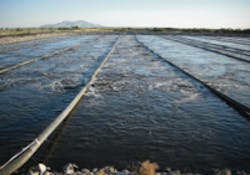Raising Standards
A wastewater treatment facility in Grantsville, Utah, operated on a lagoon aeration treatment system consisting of three treatment ponds with surface aerators and six storage ponds without any aeration equipment. The existing aeration system only allowed effluent to be discharged during summer months due to permit requirements. The city wanted a more efficient system that would allow a continuous discharge of treated effluent and have the capacity to meet future requirements for ammonia removal. To accomplish this, the city would have to increase the treatment volume by either converting existing nonaeration ponds to aeration ponds or constructing new ponds that meet state requirements.
The facility’s discharge permit required concentrations for biochemical oxygen demand and total suspended solids to be 30 mg/L or less, and ammonia concentrations in the final effluent to be reported. To design and upgrade the treatment plant’s capacity, the city contracted with AQUA Engineering Inc., located in Bountiful, Utah.
Responding to the city of Grantsville’s wastewater treatment plant needs, Environmental Dynamics Inc. (EDI) proposed using its ATLAS DBBR, a lagoon-based extended aeration system that treats the raw wastewater using a batch reactor process. The technique provides continuous inflow of raw wastewater. The water then undergoes a sequenced aeration reaction/mixing phase, followed by a settling phase. Finally, the water is decanted and discharged to treatment ponds. The effluent quality produced would meet state requirements and allow continuous effluent discharge. The process also creates nitrification and denitrification that aids in the plant’s future ammonia removal needs.
“EDI’s hybrid extended aeration process allowed the plant to utilize their existing infrastructure to treat sewage without adding lagoon volume,” said Darin Starr, EDI sales manager. “The plant is now able to run more efficiently while reducing extra costs.”
The EDI ATLAS DBBR system equipment was installed in treatment lagoon 1 after removing the existing surface aerators. Equipment required for the upgrade included EDI’s floating lateral aeration system with FlexAir 88S fine-bubble diffuser assemblies, a BioReef curtain and four 24-in.-diameter decant pipes with electric actuated valves, system control panel and three 220-hp turbo blowers.
